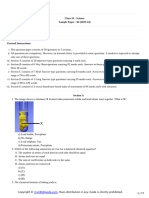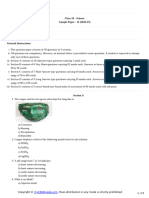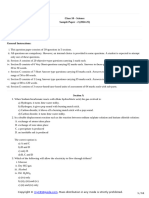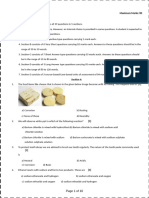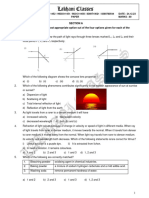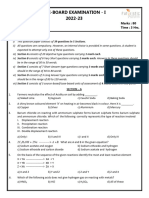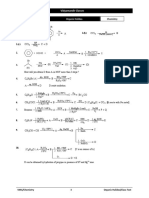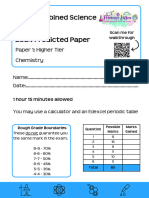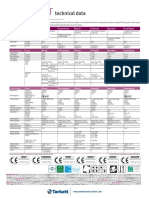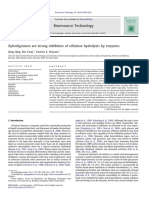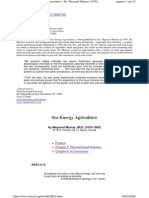10 Science23 24 sp01
10 Science23 24 sp01
Uploaded by
julijeneliyaCopyright:
Available Formats
10 Science23 24 sp01
10 Science23 24 sp01
Uploaded by
julijeneliyaOriginal Description:
Original Title
Copyright
Available Formats
Share this document
Did you find this document useful?
Is this content inappropriate?
Copyright:
Available Formats
10 Science23 24 sp01
10 Science23 24 sp01
Uploaded by
julijeneliyaCopyright:
Available Formats
myCBSEguide
Class 10 - Science
Sample Paper - 01 (2023-24)
Maximum Marks: 80
Time Allowed: : 3 hours
General Instructions:
i. This question paper consists of 39 questions in 5 sections.
ii. All questions are compulsory. However, an internal choice is provided in some questions. A student is expected to attempt
only one of these questions.
iii. Section A consists of 20 objective-type questions carrying 1 mark each.
iv. Section B consists of 6 Very Short questions carrying 02 marks each. Answers to these questions should be in the range of
30 to 50 words.
v. Section C consists of 7 Short Answer type questions carrying 03 marks each. Answers to these questions should be in the
range of 50 to 80 words.
vi. Section D consists of 3 Long Answer type questions carrying 05 marks each. Answers to these questions should be in the
range of 80 to 120 words.
vii. Section E consists of 3 source-based/case-based units of assessment of 04 marks each with sub-parts.
Section A
1. Four test tubes containing solutions (I), (II), (III) and (IV) are shown below along with their colours. Zinc sulphate is
contained in
a) II
b) IV
c) I
d) III
2. PbI2 is ________ in colour.
a) grey
b) green
c) red
d) yellow
3. When concentrated acid is added to H2O, the reaction is:
a) exothermic
b) normal
c) does not occur
d) endothermic
4. Which of the following is used for antifreeze mixture?
a) C2H5OH
b) CH3OH
Copyright © myCBSEguide.com. Mass distribution in any mode is strictly prohibited.
1 / 15
myCBSEguide
c) HCHO
d) CH3COOH
5. Take three boiling tubes A, B and C. Pour some water in test tube A Put iron nails in it and cork it. Pour boiled distilled
water in another test tube B and put iron nails in it. Add 1 ml of oil over it such that oil floats over it and prevents the air
from entering. Take some iron nails in test tube C and put some anhydrous calcium chloride in it and cork it.
Leave all the three test tubes for one day and then observe.
In which test tube nail is rusted?
a) Tube B and C
b) Tube B
c) Tube A
d) Tube A and C
6. 2Fe2O3 + 3C → 4Fe + 3CO. In the given reaction C acts as:
a) Dehydrating agent
b) Reducing agent
c) Oxidising agent
d) Catalyst
To practice more questions & prepare well for exams, download myCBSEguide App. It provides complete study
material for CBSE, NCERT, JEE (main), NEET-UG and NDA exams. Teachers can use Examin8 App to create similar
papers with their own name and logo.
7. The property of catenation is more marked in case of
a) Carbon
b) Hydrogen
c) Nitrogen
d) Oxygen
8. A student had drawn the diagram of stomata as shown below in a hurry. He could not be given full marks as he
a) did not draw neclei, in guard cells and other cells
b) did not label the stoma in its correct position
c) should have drawn nuclei and chloroplasts in guard cells and nuclei in all epidermal cells
d) forgot to draw nuclei in guard cells and also to label the diagram
9. Match the following with correct response.
Column A Column B
(i) Genes (a) Units of inheritance
Copyright © myCBSEguide.com. Mass distribution in any mode is strictly prohibited.
2 / 15
myCBSEguide
(ii) Factors (b) Impressions of past organism
(iii) Fossils (c) Entities which control the expression of traits
(iv) Sex chromosomes (d) Determine sex of an individual
a) (i) - (b), (ii) - (d), (iii) - (a), (iv) - (c)
b) (i) - (a), (ii) - (c), (iii) - (b), (iv) - (d)
c) (i) - (c), (ii) - (b), (iii) - (d), (iv) - (a)
d) (i) - (d), (ii) - (a), (iii) - (c), (iv) - (b)
10. In human beings, fertilization of ovum takes place in:
a) Fallopian tubes
b) Ovary
c) Uterus
d) Vagina
11. Which of the following is not a nitrogenous base?
a) Cytosine
b) Deoxyribose sugar
c) Guanine
d) Adenine
12. Which is the correct sequence of parts in the human alimentary canal?
a) Mouth → stomach → small intestine → oesophagus → large intestine
b) Mouth → oesophagus → small intestine → large intestine
c) Mouth → oesophagus → stomach → large intestine → small intestine
d) Mouth → oesophagus → stomach → small intestine → large intestine
13. Two wires are placed in parallel; repulsion force and current in these two wires are f and I respectively. What will be a
force if the current is doubled in each wire?
a) 4f
f
b) 2
2f
c) 4
d) 2f
14. The substance having infinitely high electrical resistance is called:
a) Conductor
b) Insulator
c) Resistor
d) Superconductor
15. Flow of energy is unidirectional. It means that
a) Energy which passes to the higher trophic levels doesn’t come back to lower trophic levels.
b) The energy of the autotrophs reaches back to the solar input.
c) None of these
d) Energy always flows form east to west direction.
16. In a food chain, the third trophic level is always occupied by
a) Producers
b) Decomposers
c) Herbivores
d) Carnivores
17. Assertion (A): Hydrogen peroxide is kept in coloured bottles.
Reason (R): Hydrogen peroxide is a moderately reactive metal that can react with light or heat slowly to produce water.
Copyright © myCBSEguide.com. Mass distribution in any mode is strictly prohibited.
3 / 15
myCBSEguide
a) Both A and R are true and R is the correct explanation of A.
b) Both A and R are true but R is not the correct explanation of A.
c) A is true but R is false.
d) A is false but R is true.
18. Assertion (A): Unisexual flowers have separate male and female flowers whereas a typical monocot embryo comprises
an embryonal axis with single cotyledon.
Reason (R): Cucumber, pumpkin and watermelon are examples of unisexual flowers.
a) Both A and R are true and R is the correct explanation of A.
b) Both A and R are true but R is not the correct explanation of A.
c) A is true but R is false.
d) A is false but R is true.
19. Assertion (A): Basic difference between an electric line and magnetic line of force is that former is discontinuous and
the later is continuous or endless.
Reason (R): No electric lines of force exist inside a charged body but magnetic lines do exist inside a magnet.
a) Both A and R are true and R is the correct explanation of A.
b) Both A and R are true but R is not the correct explanation of A.
c) A is true but R is false.
d) A is false but R is true.
20. Assertion (A): Biotic components of ecosystem continuously require energy to carry on life processes.
Reason (R): Abiotic components are the non-living factors of the ecosystem.
a) Both A and R are true and R is the correct explanation of A.
b) Both A and R are true but R is not the correct explanation of A.
c) A is true but R is false.
d) A is false but R is true.
Section B
21. What is an aldehyde? Give one example?
22. i. Write one difference between asexual and sexual modes of reproduction.
ii. Which species is likely to have better chances of survival, the one reproducing asexually or the one reproducing
sexually? Justify your answer.
23. What will happen to a plant if its xylem is removed?
OR
What precuation should be taken while preparing a good temporary mount of leaf peel to observe stomata ?
24. For what position of an object, a concave mirror forms a real image equal in size to the object?
25. There are no predators for tiger or lion. Why?
OR
Why plants are called as producers?
26. Why chickens come out late in the morning and return early in the evening ?
Section C
27. Hydrogen is not a metal but it has been assigned a place in the reactivity series of metals. Explain.
28. i. Distinguish between ionic and covalent compounds under the following properties:
a. Strength of forces between constituent elements
b. Solubility of compounds in water
c. Electrical conduction in substances
ii. Explain how the following metals are obtained from their compounds by the reduction process:
Copyright © myCBSEguide.com. Mass distribution in any mode is strictly prohibited.
4 / 15
myCBSEguide
a. Metal M which is in the middle of the reactivity series.
b. Metal N which is high up in the reactivity series. Give one example of each type.
OR
i. How do you classify elements into metals and non-metals on the basis of their electronic configuration? Choose
metal and non-metal out of the following:
23 19 24 31 35
A, B, C, D, E
11 9 12 15 17
ii. What type of bond will be formed if
a. 'A' combines with 'B'?
b. 'A' combines with 'E'?
c. 'C' combines with 'E'?
d. 'D' combines with 'E'?
29. i. Write the correct sequence of steps followed during journey of oxygen rich blood from lungs to various organs of
human body.
ii. What happens when the system of blood vessels develop a leak?
30. A man with type A blood has a wife with type B. They have a child with type O blood. Give the genotype of all the
three. What other blood groups can be expected in the future offspring of this couple?
31. How are the power and focal length of a lens related? You are provided with two lenses of focal length 20 cm and 40 cm
respectively. Which lens will you use to obtain more convergent light?
32. Find the equivalent resistance of the following combinations of resistors:
a.
b.
33. a. State Joule's law of heating. Express it mathematically when an appliance of resistance R is connected to a source of
voltage V and the current I flows through the appliance for a time t.
b. A 5Ω resistor is connected across a battery of 6 volts. Calculate the energy that dissipates as heat in 10s.
Section D
34. a. Explain the process of preparation of soap in laboratory.
b. Why is common salt (sodium chloride) added during the preparation of soap?
c. Why is soap not suitable for washing clothes when the water is hard?
OR
Give an example of each of the following.
i. A carbon compound containing two double bonds.
ii. A molecule in which central atom is linked to three other atoms.
iii. A compound containing both ionic and covalent bonds.
iv. An organic compound which is soluble in water.
v. A carbon compound which burns with a sooty flame.
35. Why are budding, fragmentation and regeneration all considered as asexual types of reproduction? With neat diagrams
explain the process of regeneration in Planaria.
OR
Copyright © myCBSEguide.com. Mass distribution in any mode is strictly prohibited.
5 / 15
myCBSEguide
Nervous and hormonal system together perform the function of control and co-ordination in human beings". Justify the
statement.
36. An object 5 cm high is placed at a distance of 10 cm from a convex mirror of radius of curvature 30 cm. Find the nature,
position and size of the image.
OR
i. Draw a labelled ray diagram to show the path of a ray of light incident obliquely on one face of a glass slab.
ii. Calculate the refractive index of the material of a glass slab. Given that the speed of light through the glass slab is 2
× 108 m/s and in air is 3 × 108 m/s.
iii. Calculate the focal length of a lens, if its power is - 2.5 D.
To practice more questions & prepare well for exams, download myCBSEguide App. It provides complete study
material for CBSE, NCERT, JEE (main), NEET-UG and NDA exams. Teachers can use Examin8 App to create similar
papers with their own name and logo.
Section E
37. Read the text carefully and answer the questions:
A scale for measuring hydronium ion in a solution is called the pH scale. The pH of a neutral solution is 7. A value of
less than 7 on the pH scale represents an acidic solution. As the pH value, increases from 7 to 14 it represents OH- ion
concentration in solution i.e a basic solution.
i. What is the pH range of the Human Body?
ii. The strength of acid and bases depends on which factor?
OR
If the pH of soil X is 7.5 while that of soil Y is 4.5, then which soil should be treated with powdered chalk to adjust its
pH?
38. Read the text carefully and answer the questions:
In animals, control and coordination are provided by nervous and muscular tissues. Touching a hot object is an urgent
and dangerous situation for us. We need to detect it and respond to it. How do we detect that we are touching a hot
object? All information from our environment is detected by the specialised tips of some nerve cells. These receptors are
usually located in our sense organs, such as the inner ear, the nose, the tongue, and so on. So gustatory receptors will
detect taste while olfactory receptors will detect the smell. This information, acquired at the end of the dendritic tip of a
nerve cell sets off a chemical reaction that creates an electrical impulse. This impulse travels from the dendrite to the cell
body, and then along the axon to its end. At the end of the axon, the electrical impulse sets off the release of some
chemicals. These chemicals cross the gap, or synapse, and start a similar electrical impulse in the dendrite of the next
neuron. This is a general scheme of how nervous impulses travel in the body. A similar synapse finally allows the
delivery of such impulses from neurons to other cells, such as muscles cells or glands.
Copyright © myCBSEguide.com. Mass distribution in any mode is strictly prohibited.
6 / 15
myCBSEguide
i. Why does the flow of signals in a synapse from axonal end of one neuron to dendritic end of another neuron
take place but not in the reverse direction?
ii. From where the electrical impulse travels?
iii. Name the chemical which released at the end of axon to transmit the signal to the other neuron.
OR
What happens at the synapse between 2 neurons?
39. Read the text carefully and answer the questions:
Take two different coils of copper wire having large number of turns, say 50 and 100 turns respectively. Insert them over
a non-conducting roll as shown in the given figure. Connect the Coil-1, having large number of turns, in series with a
battery and a plug key. Also connect the other Coil-2 with a galvanometer.
i. Explain the reason for the current which is responsible for the deflection in the galvanometer.
ii. Define the phenomenon involved in this case.
iii. State what is observed in the galvanometer, when
1. the key is closed.
2. the key is opened.
OR
A coil AB of copper wire is connected to a galvanometer as shown in the figure. What is observed when N-pole of a
strong bar magnet is
I. pushed into the coil?
II. held stationary inside the coil?
State the reason for each observation.
Copyright © myCBSEguide.com. Mass distribution in any mode is strictly prohibited.
7 / 15
myCBSEguide
Class 10 - Science
Sample Paper - 01 (2023-24)
Solution
Section A
1. (b) IV
Explanation: ZnSO4 solution is colourless. It is contained in IV.
2. (d) yellow
Explanation: PbI2 is not a purely ionic compound, but it is covalent. So, the colorless ions I(-) and Pb(2+) combine into
a completely new entity, PbI2. That entity is yellow in color.
3. (a) exothermic
Explanation: On adding concentrated acid to water, a large amount of heat energy is evolved resulting in an exothermic
reaction.
4. (a) C2H5OH
Explanation: Ethanol (C2H5OH) is used for antifreeze mixture. Antifreeze is an additive that lowers the freezing point
of a water-based liquid. At room temperature, ethanol is a polar solvent and is used as an antifreeze.
5. (c) Tube A
Explanation: Iron nails get rusted in test tube A because both air and water are present in it. Iron nails do not get rusted
in B because there is water but no air. In C, rusting will not take place because there is neither air nor water.
To practice more questions & prepare well for exams, download myCBSEguide App. It provides complete study
material for CBSE, NCERT, JEE (main), NEET-UG and NDA exams. Teachers can use Examin8 App to create similar
papers with their own name and logo.
6. (b) Reducing agent
Explanation: Carbon acts as a reducing agent and gets oxidized in the process of reducing iron oxide to iron.
7. (a) Carbon
Explanation: Catenation is the bonding of atoms of the same element into a series, called a chain. A chain may be open
if its ends are not bonded to each other (an open-chain compound), or closed if they are bonded in a ring (a cyclic
compound).
Catenation occurs most readily with carbon, which forms covalent bonds with other carbon atoms to form longer chains
and structures. This is the reason for the presence of the vast number of organic compounds in nature.
8. (c) should have drawn nuclei and chloroplasts in guard cells and nuclei in all epidermal cells
Explanation: Guard cells contains nuclei and chloroplast.
9. (b) (i) - (a), (ii) - (c), (iii) - (b), (iv) - (d)
Explanation:
Genes are the primary unit of inheritance that are specific for a specific individual.
Factors are the traits which are transferred from parents to offsprings.
Fossils are the dead remains of extinct species.
Sex chromosomes decide the sex of an organism whereas autosomes decide the phenotypic expressions.
10. (a) Fallopian tubes
Explanation: The fertilization of ovum takes place in the ampulla of the fallopian tube.
Copyright © myCBSEguide.com. Mass distribution in any mode is strictly prohibited.
8 / 15
myCBSEguide
11. (b) Deoxyribose sugar
Explanation: A nitrogenous base is simply a nitrogen-containing molecule that has the same chemical properties as a
base. They are particularly important since they make up the building blocks of DNA and RNA: adenine, guanine,
cytosine, thymine, and uracil.
12. (d) Mouth → oesophagus → stomach → small intestine → large intestine
Explanation: The human alimentary canal consists of organs of digestion which are in the sequence as follows:
Mouth → oesophagus → stomach → small intestine → large intestine
13. (a) 4f
Explanation: 4f
14. (b) Insulator
Explanation: Insulator
15. (a) Energy which passes to the higher trophic levels doesn’t come back to lower trophic levels.
Explanation: The flow of energy in an ecosystem is always unidirectional. It means that as the energy moves
progressively through the various trophic levels, it is no longer available to the previous level. The energy that is
captured by the autotrophs (producers) does not revert back to the solar input. The energy which passes to the herbivores
(primary consumers) does not come back to the autotrophs (producers).
16. (d) Carnivores
Explanation: First trophic level are producers, second tropic level are herbivores, third trophic level is occupied by
carnivores.
17. (c) A is true but R is false.
Explanation: Hydrogen peroxide is a highly reactive metal that can react with light or heat to produce water. It
decomposes into water and oxygen in the presence of sunlight. To prevent this reaction with light and heat it is stored in
coloured bottles so that light cannot pass through it. Thus assertion is true, but reason is false.
18. (b) Both A and R are true but R is not the correct explanation of A.
Explanation: Unisexual flowers have separate male and female flowers. The example includes cucumber, pumpkin and
watermelon.
19. (a) Both A and R are true and R is the correct explanation of A.
Explanation: In case of the electric field of an electric dipole, the electric lines of force originate from positive charge
and, end at negative charge. Since, isolated magnetic lines are closed continuous loops extending throughout the body of
magnet, hence they from endless curves.
20. (b) Both A and R are true but R is not the correct explanation of A.
Explanation: Both A and R are true but R is not the correct explanation of A.
Section B
21. Aldehyde is an organic compound which contains - CHO group in its molecule.
Example: CH3CHO : Ethanol
22. Sexual reproduction takes place with the help of fusion of male and female gametes, thus 2 haploid gametes restore the
diploid nucleus and thus form zygote, which have content from both the parent and hence producing a new
recombination Whereas, in asexual reproduction the offspring develops from a single parent, the genetic material of the
offspring is exact copy of the single parent.
Better chances of survival are seen in sexually reproducing organisms. This is because variation occurs in sexual
reproduction which improves the vigour and vitality of the individual. This is helpful for the organisms in better
adaptability to the environment.
23. The xylem tissue transports water and minerals from the roots to the leaves of a plant for photosynthesis. If xylem is
removed, upward movement of water will stop leading to wilting of leaves and ultimately leading to the death of the
plant.
Copyright © myCBSEguide.com. Mass distribution in any mode is strictly prohibited.
9 / 15
myCBSEguide
OR
1. Cut the peel to a proper size and avoid folding it.
2. Always place the peel at the centre of the slide and hold the slide at the edges.
3. Do not overstrain or under strain the peel.
4. Always handle the peel with a brush as a needle may damage the cells.
5. Take care to prevent the peel from drying by using glycerin.
6. Place the coverslip gently, avoiding any air bubbles.
7. Remove excess stain and glycerine with a blotting paper.
24. When an object is kept at the center of curvature of the concave mirror than the image formed is real, inverted and equal
to the size of the object.
The figure below shows the ray diagram follows:
25. Lions and tigers are the secondary or tertiary consumers at the highest trophic level. They are largest animals which feed
upon the secondary carnivores like wolves etc. they are not killed and eaten by other animals. Certain physical
adaptations like strong canine teeth, large size & very strong sharp claws etc. makes them practically the strongest
predators which can not be further eaten by any other organism.
OR
Plants are called producers, because they produce thier own food. they do this by using light energy from the sun, carbon
dioxide from the air and water from the soil to produce food in the form of glucose (sugar) the process is called
photosynthesis.
26. Chickens have very few rods on the retina, hence they are able to see only in intense light and not in dim-light.
Section C
27. Hydrogen has a tendency to lose an electron and forms a positive ion H+ like metals although hydrogen is not a metal yet
it has been assigned a place in the reactivity series of metals. The metals which lose electrons less readily than hydrogen
are placed below it and the metals which lose electrons more readily than hydrogen are placed above it in the reactivity
series of metals.
28. i.
a. Ionic compounds have strong force of attraction between the oppositely charged ions (e.g., N a and C l ), so
+ −
they are solids. Covalent compounds have weak force of attraction between their molecules, so they are usually
liquids or gases.
b. Ionic compounds are soluble in water but covalent compounds are insoluble in water.
c. Ionic compounds conduct electricity when dissolved in water or when melted because they contain ions (charged
particles). But, covalent compounds like glucose do not conduct electricity because they do not contain ions.
ii.
a. The metal M which is in the middle of the reactivity series (such as iron, zinc, lead, copper, etc.) is moderately
reactive. So, for obtaining such metals from their compounds, their sulphides and carbonates (in which they are
present in nature) are first converted into their oxides by the process of roasting and calcination respectively. For
example,
Copyright © myCBSEguide.com. Mass distribution in any mode is strictly prohibited.
10 / 15
myCBSEguide
H eat
2ZnS (s) + 3O2 (g) ⟶ 2ZnO (s) + 2S O2 (g)
Zinc Sulphide
(Su lphideore)
H eat
ZnC O3 (s) ⟶ ZnO (s) + C O2 (g)
Zinc C arbonate
(C arbonate are)
The metal oxide (MO) are then reduced to the corresponding metals by using suitable reducing agents such as
carbon. For example, zinc metal from its oxide is obtained as follow:
ZnO(s) + C (s) → Zn(s) + C O(g)
Zinc oxide Zinc
b. The metal N which is high up in the reactivity series (such as sodium, magnesium, calcium, aluminium, etc.), is
very reactive and cannot be obtained from its compound by heating with carbon.
Therefore, such metals are obtained by electrolytic reduction of their molten salt. For example, sodium is
obtained by the electrolysis of molten sodium chloride (N aC l).
OR
i. Elements which contain 1 to 3 electrons in their outermost shell are metals. Elements containing 4 to 7 electrons in
their valence shell are non-metals.
Electronic configurations:
23
N a(Z = 11 ) = 2, 8, 1
11
19
B(Z = 9) = 2, 7
9
24
C (Z = 12) = 2, 8, 2
12
31
D(Z = 15) = 2, 8, 5
15
35
E(Z = 17) = 2, 8, 7
17
Hence A and C are metals whereas, B, D and E are non-metals.
ii. Type of bonds
a. 'A' is metal and 'B' is non-metal, so the bond formed will be ionic.
A =2, 8,1 B = 2, 7
b. 'A' is metal and 'E is non-metal, so the bond formed is ionic.
A = 2, 8, 1 B = 2, 7
c. 'C' is metal and 'E' is non-metal, so the bond formed is ionic.
C = 2, 8, 2 E = 2, 8, 7
Copyright © myCBSEguide.com. Mass distribution in any mode is strictly prohibited.
11 / 15
myCBSEguide
d. 'D' is a non-metal and 'E' is also a non-metal, so the bond formed will be covalent.
P ulmonary
29. i. The correct sequence is blood flow from the Lungs −−−−−−→ Left sides of the heart → Ventricle → Aorta → Body
vein
organs
ii. The leaked blood flows into surrounding tissues leading to accumulation of blood. This condition is known as
hematoma.
30. a. Genotypes. Man (IA IO) Mother IB IO and child IO IO.
b. Blood group of the future offspring. A type, B type, O type and AB type. It is based on the following cross:
31. P =
1
,P ∝
1
f f
The power of the lens is inversely proportional to the focal length of the lens. A lens with the focal length 20 has more
power than a lens with a focal length of 40 cm.
Therefore, a lens with higher power should be used to obtain more convergent light.
32. a. Here, 2Ω , 3Ω and 6Ω resistance are connected in series.
Req = R1 + R2 + R3
=2+3+6
= 11
b. 1
Req
=
1
2
+
1
3
+
1
1 3+2+1
=
Req 6
1 6
=
Reg 6
Req = 1Ω
33. a. Statement of Joule's law
Joule’s law of heating states that, when a current 'i' passes through a conductor of resistance ‘R’ for time ‘t’ then the
heat developed in the conductor is equal to the product of the square of the current, the resistance and time.
Mathematical explanation
Let H be the heat produced when a current 'i' passes through a conductor of resistance ‘r’ for time ‘t’ then
i. H ∝ i 2
ii. H ∝ R
Copyright © myCBSEguide.com. Mass distribution in any mode is strictly prohibited.
12 / 15
myCBSEguide
iii. H ∝ t
∴ H ∝ i2Rt
⇒ H = i2Rt
b. Here V = 6V and R = 5Ω
The current flowing through the resistor I = = 1.2 A
V 6V
=
R 5Ω
∴ H = I2RT = (1.2)2 × 5 × 10 = 72J
Section D
34. a. Soap can be prepared in the laboratory as follows:
i. Take about 20 ml of castor oil in a beaker.
ii. Add 30 ml of 20 % sodium hydroxide (NaOH) solution to it.
iii. Heat the mixture with constant stirring till a paste of soap is formed.
iv. Then add 5 to 10 grams of common salt (NaCl).
v. Stir the mixture well and allow it to cool. On cooling the solution, solid soap separates out.
vi. When the soap sets, it can be cut into pieces called 'soap bars'.
b. Common salt(NaCl) is added to the mixture to make the soap come out of the solution. Though most of the soap
separates out on its own, some of it remains in the solution. Common salt is added to precipitate out all the soap from
the aqueous solution.
c. When soap is used for washing clothes with hard water, a large amount of soap in water reacts with the calcium(Ca)
and magnesium(Mg) ions of hard water to form an insoluble precipitate called scum, before it can be used for the real
purpose of washing.
OR
i. Carbon dioxide (CO2) contains two double bonds.
ii. In Ammonia molecule (NH3) , Nitrogen is central atom , it is linked to three hydrogen atoms.
¨
H − N − H
|
H
iii. Ammonium chloride (NH4 CI) contains both ionic and covalent bonds.
iv. Alcohols such as Ethanol (CH3CH2OH) is soluble in water.
v. Unsaturated compounds like ethane, ethyne, benzene etc., burn with a sooty flame.
35. Budding, fragmentation and regeneration are all example of asexual reproduction because all of them involve only one
parent. Male and female gametes are not involved in the reproduction. Thus in all of the three process no variation is
produced.
Planaria can be cut into any number of pieces and each piece grows into a complete organism. This process is known as
regeneration (see fig.) Regeneration is carried out by specialised cells known as neoblast ( adult stem cells ).
These cells proliferate and produce large numbers of cells. From this mass of cells, different cells undergo changes to
become various cell types and tissues, giving rise to whole new organism with same DNA content as its parent. These
Copyright © myCBSEguide.com. Mass distribution in any mode is strictly prohibited.
13 / 15
myCBSEguide
changes take place in an organised manner referred to as development.
OR
The nervous system controls and coordinates all the functions in the body. It carries out its functions in close
coordination with the hormonal system. Nerves don’t reach every nook and corner of the body and hence needs
assistance from the hormones to control all the parts of the body. Moreover, while the nervous control is somewhat
faster, hormonal control is slower. Hormonal control is mainly based on feedback mechanism and tells the body to either
pace up or slow down; as per the situation. Nervous control, on the other hand, is more of a direct control. Both of them
complement each other. Thus, it can be said that nervous and hormonal systems together perform the function of control
and coordination in human beings.
36. Here u = - 10 cm (u is always negative), v = ?
r +30
f = = or f = +15cm
2 2
f and r for convex mirror are always positive.
Using the formula = +
1
we have 1
v
1
u
1
15
=
1
v
−
1
10
or
f
1 1 1 5
= + = v
v 15 10 30
v = +6 cm
or ∴ Image is 6 cm behind the mirror (right or mirror).
It is virtual and errect.
−(+6)
Magnification m = −
v
u
=
−10
= 0.6
Hence image is 0.6 times the size of the object.
h2
Again m =
h1
where h2 is the size of the image and h1 the size of the object.
∴ h2 = mh1= 0.6(5)= 3 cm.
Hence image is 3 cm. high.
OR
i. The ray diagram shows the path of a ray of light incident obliquely on one face of a glass slab:
Copyright © myCBSEguide.com. Mass distribution in any mode is strictly prohibited.
14 / 15
myCBSEguide
ii. The glass refractive index is defined as the ratio between the speed of light in the vacuum and the speed of light in
the glass.
Refractive index of glass (ng) = Speed of light in vacuum/speed of light in the glass.
8
ng =
3×10
8
2×10
ng = 1.5
iii. P = 1
f(inmeter)
f= 1
=
1
=
1
P 2.5 −25
−1000
⇒ f= 25
cm = - 40 cm
The focal length (f) of a concave lens is always negative.
To practice more questions & prepare well for exams, download myCBSEguide App. It provides complete study
material for CBSE, NCERT, JEE (main), NEET-UG and NDA exams. Teachers can use Examin8 App to create similar
papers with their own name and logo.
Section E
37. i. The pH range of the Human Body is 7 to 7.8.
ii. The strength of acids and bases depends on the number of H+ ions produced and the number of OH- ions
produced.
OR
Soil Y is acidic. Hence, it should be treated with powdered chalk to reduce its acidity.
38. i. At the synapse, (functional junction between neurons) axon terminal comes in close proximity to the dendron
terminal of next neuron. Axon terminal is expanded to form pre-synaptic knob and the other dendrite terminal
forms post- synaptic depression.
ii. The electrical impulse travels form the dendrite to the cell body, then along the axon to its end.
iii. Acetylcholine is released at the end of the axon to transmit the signal to the other neuron.
OR
A synapse is a gap between two neurons. At the synapse, the electrical signals are converted into chemicals that
can easily cross over the gap and pass on to the next neurons where it again converted into electrical signals.
39. i. The reason involved is electromagnetic induction.
When current is passed through coil 1 magnetic field changes in coil 2 due to which an induced current starts
flowing in coil 2 and the galvanometer present in coil 2 shows some deflection.
ii. The electromagnetic induction is the phenomenon involved above.
The process by which a changing magnetic field in a conductor induces a current in another conductor is called
electromagnetic induction.
iii. 1. A momentary deflection is shown by the galvanometer.
2. A momentary deflection is shown by the galvanometer but in the opposite direction.
OR
i. When bar magnet is pushed into the coil there is some deflection in the galvanometer.
ii. When bar magnet is held stationary there is no change in magnetic field due to which there is no change in
the galvanometer.
Copyright © myCBSEguide.com. Mass distribution in any mode is strictly prohibited.
15 / 15
You might also like
- Sahodaya 23-24 Copy of Science Set 2Document12 pagesSahodaya 23-24 Copy of Science Set 2Aparajita Bose71% (17)
- Pre Board Sci-1 Question PaperDocument8 pagesPre Board Sci-1 Question PaperJAYANTA BANIKNo ratings yet
- O Level Biology Practice Questions And Answers: Heredity And Molecular GeneticsFrom EverandO Level Biology Practice Questions And Answers: Heredity And Molecular GeneticsNo ratings yet
- 10 Science23 24 sp02 06.12..Document16 pages10 Science23 24 sp02 06.12..tiwaririahabhNo ratings yet
- 10 Science SP 10Document18 pages10 Science SP 10preetishelke6400No ratings yet
- 10_science_sp_10Document16 pages10_science_sp_10Surinder GodaraNo ratings yet
- 10 Science23 24 sp04Document17 pages10 Science23 24 sp04sohanksijoy6dNo ratings yet
- 10_science_sp_11Document15 pages10_science_sp_11Surinder GodaraNo ratings yet
- 10_science_sp_09Document15 pages10_science_sp_09Surinder GodaraNo ratings yet
- my cbse sample-6_removedDocument9 pagesmy cbse sample-6_removedbhuvanisthebest1No ratings yet
- my cbse sample-6Document17 pagesmy cbse sample-6bhuvanisthebest1No ratings yet
- My Cbse Sample-3Document16 pagesMy Cbse Sample-3bhuvanisthebest1No ratings yet
- 10 Science SP 05Document16 pages10 Science SP 05k73545149No ratings yet
- 9 Science23 24 sp01Document14 pages9 Science23 24 sp01parikaushal40No ratings yet
- 10 Science23 24 sp06Document17 pages10 Science23 24 sp06sohanksijoy6dNo ratings yet
- My Cbse Sample-2_removedDocument7 pagesMy Cbse Sample-2_removedbhuvanisthebest1No ratings yet
- My Cbse Sample-2Document16 pagesMy Cbse Sample-2bhuvanisthebest1No ratings yet
- 10 Science22 23 sp02Document16 pages10 Science22 23 sp02Ishneet kaur bhatiaNo ratings yet
- Class 10 ScienceDocument5 pagesClass 10 Scienceinfovarun2008jainNo ratings yet
- My Cbse Sample-1_removedDocument9 pagesMy Cbse Sample-1_removedbhuvanisthebest1No ratings yet
- 10 Science SP 01Document18 pages10 Science SP 01tanmoyjyotiboraNo ratings yet
- Science XDocument4 pagesScience XRakesh palNo ratings yet
- 10 Science23 24 sp08Document16 pages10 Science23 24 sp08sohanksijoy6dNo ratings yet
- 09_science_sp_01fDocument16 pages09_science_sp_01fBhavsmageshNo ratings yet
- Class X PreBoard QP ScienceDocument10 pagesClass X PreBoard QP ScienceanantshuklaphysicsNo ratings yet
- QP Grade 9 Science Midterm 2023-24Document8 pagesQP Grade 9 Science Midterm 2023-24obungaowoNo ratings yet
- G10 Booster Exam Science Set ADocument5 pagesG10 Booster Exam Science Set AVaishnavi RameshNo ratings yet
- X CBSE Prelim-1 Science 2Document7 pagesX CBSE Prelim-1 Science 2shubhankarbende24No ratings yet
- Science Sample Paper 2Document9 pagesScience Sample Paper 2Siddharth PalNo ratings yet
- SQP 10 FinalDocument14 pagesSQP 10 Finaldarshanbafana4No ratings yet
- Practice Paper Pre Board X Science 2023-24Document10 pagesPractice Paper Pre Board X Science 2023-24Manish MishraNo ratings yet
- X Science SQP 2018-19Document6 pagesX Science SQP 2018-19muthu100% (1)
- Sample Paper Science Class X: VSA: (1 Marks Each)Document6 pagesSample Paper Science Class X: VSA: (1 Marks Each)VinithNo ratings yet
- class 10 science question paperDocument9 pagesclass 10 science question papernahamed248No ratings yet
- SCIENCE Sample Paper 1-ConvertedDocument6 pagesSCIENCE Sample Paper 1-Convertedwww.meenu.1979No ratings yet
- SCIDocument10 pagesSCIminanaldurgeNo ratings yet
- Science - Set 11519635502Document4 pagesScience - Set 11519635502Sudarshan Rsa100% (2)
- PB II Class X Sci QP Jan 2023Document9 pagesPB II Class X Sci QP Jan 2023Mickey xz0% (1)
- X Science SQP 2018-19Document6 pagesX Science SQP 2018-19asdfNo ratings yet
- Scisqp 2Document12 pagesScisqp 2arnav.og.16No ratings yet
- Class X SA 1 (24-25)Document7 pagesClass X SA 1 (24-25)Chemistry Praveenkumar NEET&JEENo ratings yet
- Class 10 Science Halfyearly 24-25Document9 pagesClass 10 Science Halfyearly 24-25royal12likemiNo ratings yet
- XTH ScienceDocument8 pagesXTH Sciencepayaljain122640No ratings yet
- Time Allowed: 3 Hours Maximum Marks: 80 General InstructionsDocument16 pagesTime Allowed: 3 Hours Maximum Marks: 80 General Instructionsrm8707295397No ratings yet
- 10 ScienceDocument4 pages10 ScienceNIpunNo ratings yet
- GISPreboardDocument6 pagesGISPreboardHarshaNo ratings yet
- 10th Science QSTN Paper Set ADocument7 pages10th Science QSTN Paper Set Aalbertaldin00No ratings yet
- 2nd Science Ques PaperDocument8 pages2nd Science Ques Paperfahima sunasaraNo ratings yet
- Fe4 Science 7Document8 pagesFe4 Science 7anirudhjindal032No ratings yet
- 24.12.23 X (Cbse) Science PaperDocument8 pages24.12.23 X (Cbse) Science PaperMr.Saksham YadavNo ratings yet
- CSSC - Qp-Science-10-Cssc-Set 1Document8 pagesCSSC - Qp-Science-10-Cssc-Set 1Mathan100% (2)
- G-10 Science PB-1Document8 pagesG-10 Science PB-1Leela MadhuriNo ratings yet
- Grade 10 Science - QPDocument12 pagesGrade 10 Science - QPpranavv531No ratings yet
- CBSE Sample Question Papers For Class 10 Science 2018-2019Document12 pagesCBSE Sample Question Papers For Class 10 Science 2018-2019Pritpal SinghNo ratings yet
- 10th Science (EM) 3Document4 pages10th Science (EM) 3shashikala.kruthi5No ratings yet
- 10 Science Sp01Document21 pages10 Science Sp01Ipsit Swaroop BoseNo ratings yet
- science paperDocument8 pagesscience paperjosephalt1999No ratings yet
- 10th Science Official Sample Paper from CBSE for 2018-19Document15 pages10th Science Official Sample Paper from CBSE for 2018-19jeevasarasu151No ratings yet
- O Level Biology Practice Questions And Answers: Ecology And Our Impact On The EcosystemFrom EverandO Level Biology Practice Questions And Answers: Ecology And Our Impact On The EcosystemNo ratings yet
- Electrical Properties of Materials: Chap 1Document31 pagesElectrical Properties of Materials: Chap 1Shuvro Sankar SenNo ratings yet
- TTC-INDUSTRIAL AREA NewDocument76 pagesTTC-INDUSTRIAL AREA NewamitNo ratings yet
- Mechanical Diesel - 1st Sem Questions & AnswersDocument92 pagesMechanical Diesel - 1st Sem Questions & AnswersShiva Sankar BeharaNo ratings yet
- Hand PumpsDocument14 pagesHand PumpsTalha MahmoodNo ratings yet
- Class Test-2 Chemistry: Vidyamandir ClassesDocument1 pageClass Test-2 Chemistry: Vidyamandir Classesbrainx MagicNo ratings yet
- Mix DesignDocument5 pagesMix Designnutan acharyaNo ratings yet
- 010 Subsea Hose PDFDocument16 pages010 Subsea Hose PDFJhonatan FerreiraNo ratings yet
- 14 Thermal Lab 2009Document7 pages14 Thermal Lab 2009Mahir MahmoodNo ratings yet
- Edexcel - GCSE Combined Science Chemistry - Higher - Paper 1 - 2024 Predicted PaperDocument26 pagesEdexcel - GCSE Combined Science Chemistry - Higher - Paper 1 - 2024 Predicted PapernftsaremyaddictionNo ratings yet
- Air ConditioningDocument19 pagesAir ConditioningNurul AkmamNo ratings yet
- Ducted Blower Split Systems: ModelsDocument171 pagesDucted Blower Split Systems: ModelsRicardo Molina SánchezNo ratings yet
- 3.mole, Avogadro's Number, Balancing Chemical EquationDocument43 pages3.mole, Avogadro's Number, Balancing Chemical EquationNandaNo ratings yet
- Bio Medical Waste ManagementDocument5 pagesBio Medical Waste Managementanantarao75% (4)
- Reclamation of Transformer OilDocument42 pagesReclamation of Transformer Oilgaurang1111No ratings yet
- Introduction To Aspen Plus 2013 Tutorial VDocument77 pagesIntroduction To Aspen Plus 2013 Tutorial VsyafieqNo ratings yet
- BR INT Iq GRANITDocument1 pageBR INT Iq GRANITIna Hasta MandiriNo ratings yet
- Chemisorption 2017Document4 pagesChemisorption 2017AssyakurNo ratings yet
- Measurements and ErrorsDocument89 pagesMeasurements and Errorselsiesaveena96No ratings yet
- RCV-AS-02527-EN - Research Control Valve Model NumbersDocument2 pagesRCV-AS-02527-EN - Research Control Valve Model NumbersLorenzoNo ratings yet
- Modern Physics Part 2Document11 pagesModern Physics Part 2Shivam Jaggi100% (1)
- Lesson: Acid and Bases: 1 Quarter Science 7 Week 7Document10 pagesLesson: Acid and Bases: 1 Quarter Science 7 Week 7Nazzer NacuspagNo ratings yet
- Hypro D50 Service ManualDocument32 pagesHypro D50 Service Manualjimi9488No ratings yet
- Bioresource Technology: Qing Qing, Bin Yang, Charles E. WymanDocument7 pagesBioresource Technology: Qing Qing, Bin Yang, Charles E. WymanVanessa RuedaNo ratings yet
- A Study On Biological Soil Improvement Using New Environmental BacteriaDocument14 pagesA Study On Biological Soil Improvement Using New Environmental BacteriaRoozbeh OwjiNo ratings yet
- 3 Industrial Maintenance Catalog HRDocument196 pages3 Industrial Maintenance Catalog HRQuy Nguyen HDSCNo ratings yet
- Excerts of Book Sea Energy Agriculture - DR Maynard Murray - 1976 PDFDocument13 pagesExcerts of Book Sea Energy Agriculture - DR Maynard Murray - 1976 PDFJamtse Gyatso100% (2)
- Rucofin GSQ 200 New: Composition UsesDocument2 pagesRucofin GSQ 200 New: Composition UsesConsultora2100% (1)
- Safety Data Sheet: 1. IdentificationDocument8 pagesSafety Data Sheet: 1. IdentificationAditya DhuriNo ratings yet
- Walter Schloss 09 Mar 2023 1717Document2 pagesWalter Schloss 09 Mar 2023 1717minjutNo ratings yet
- Source Rock - TMDocument57 pagesSource Rock - TMHaryestha LayukNo ratings yet







